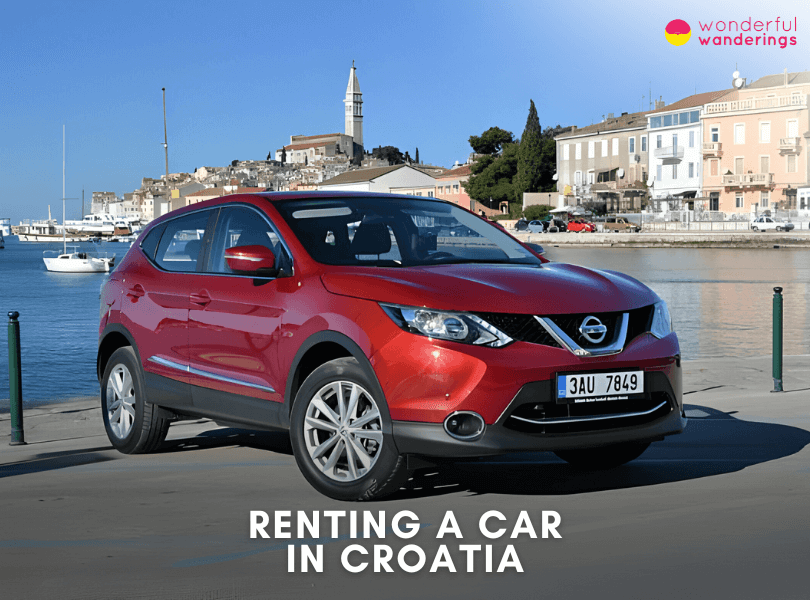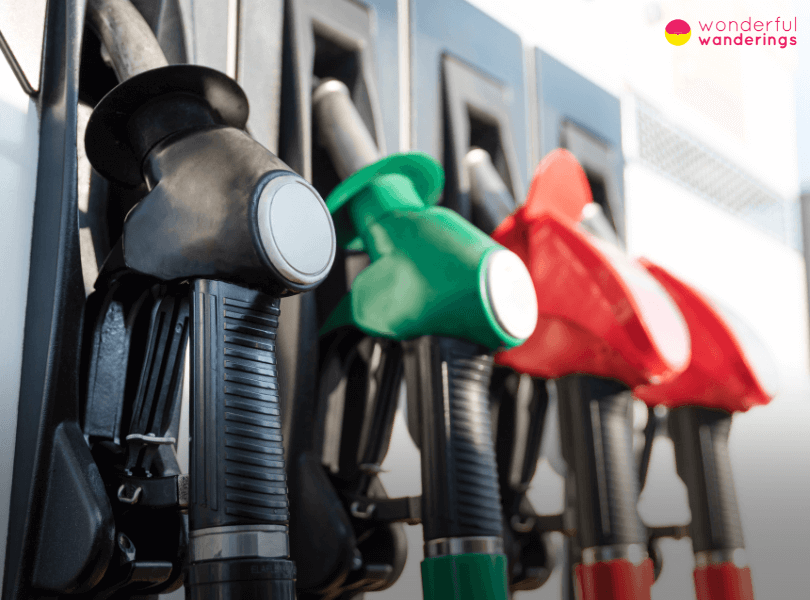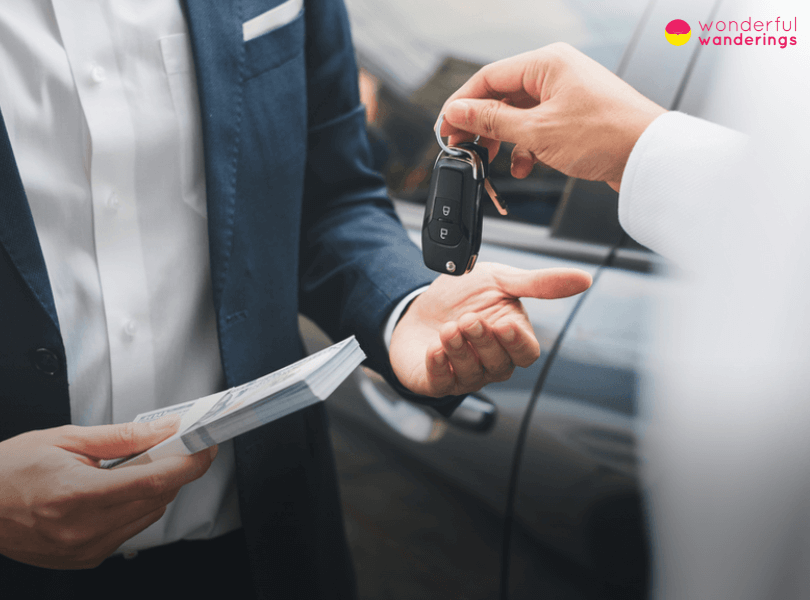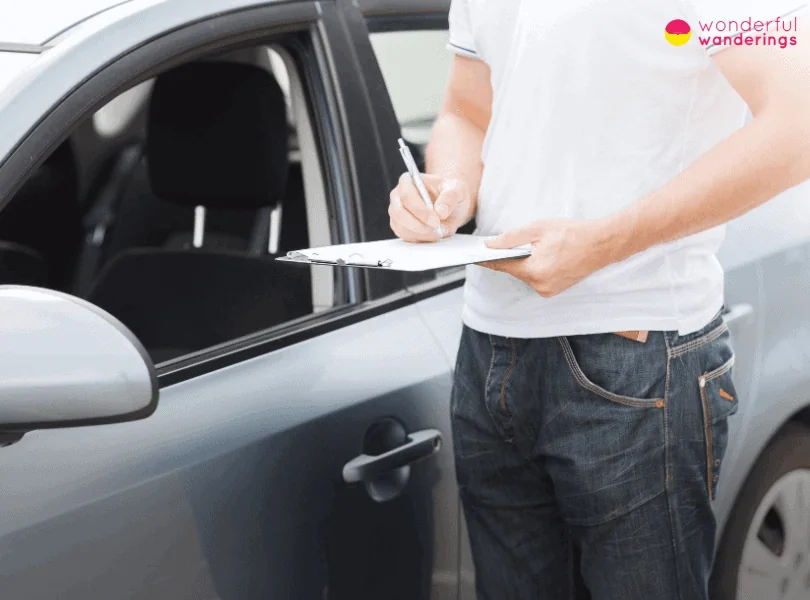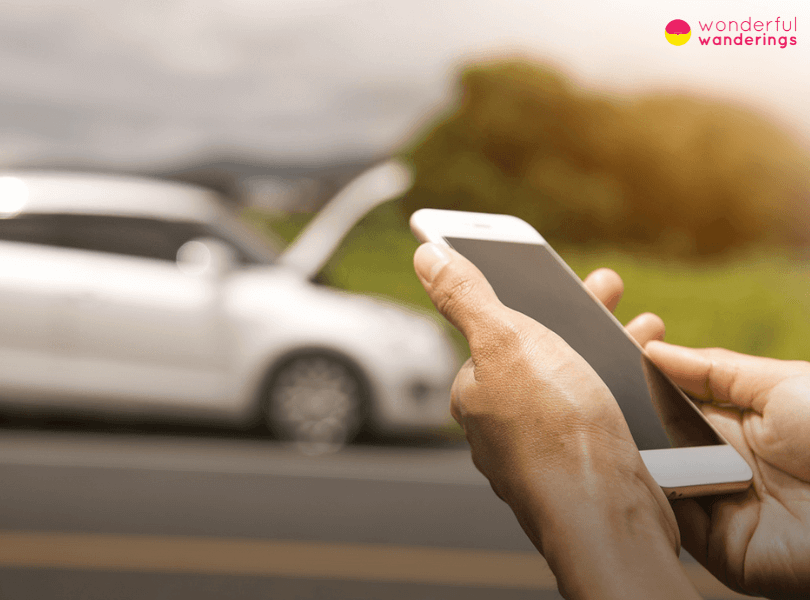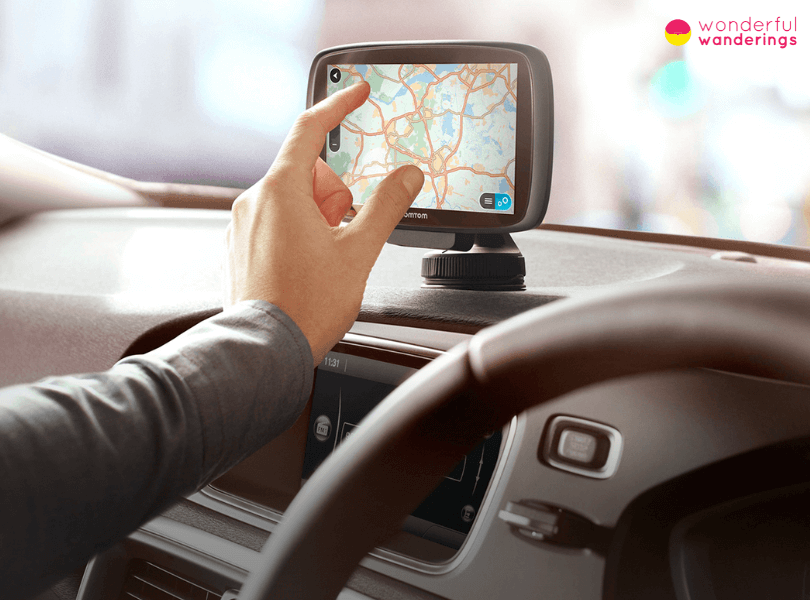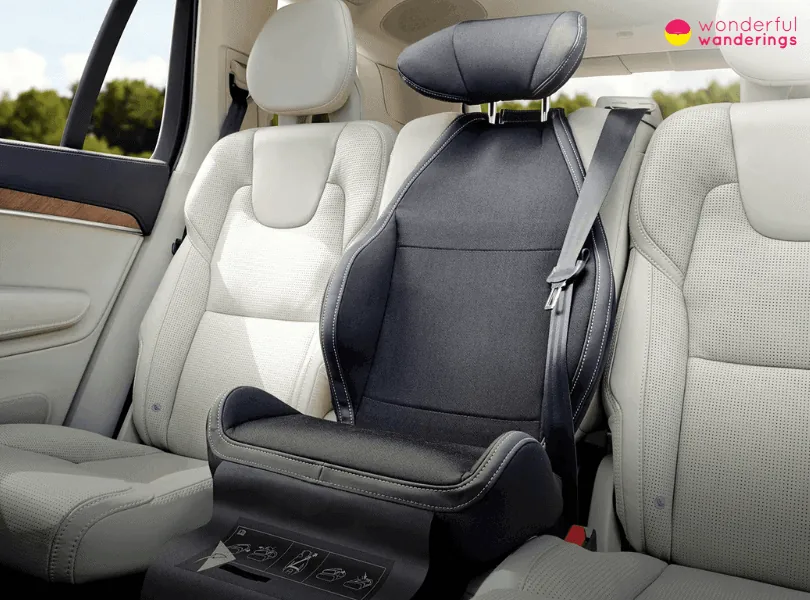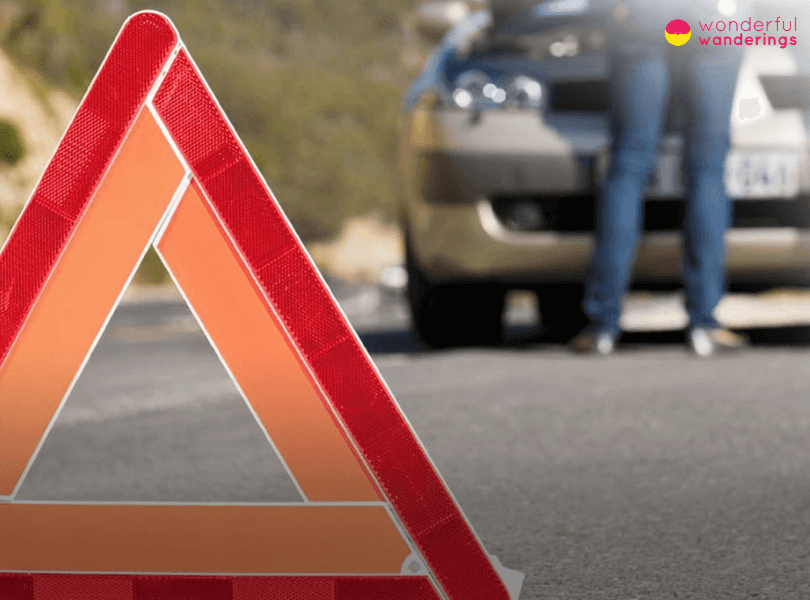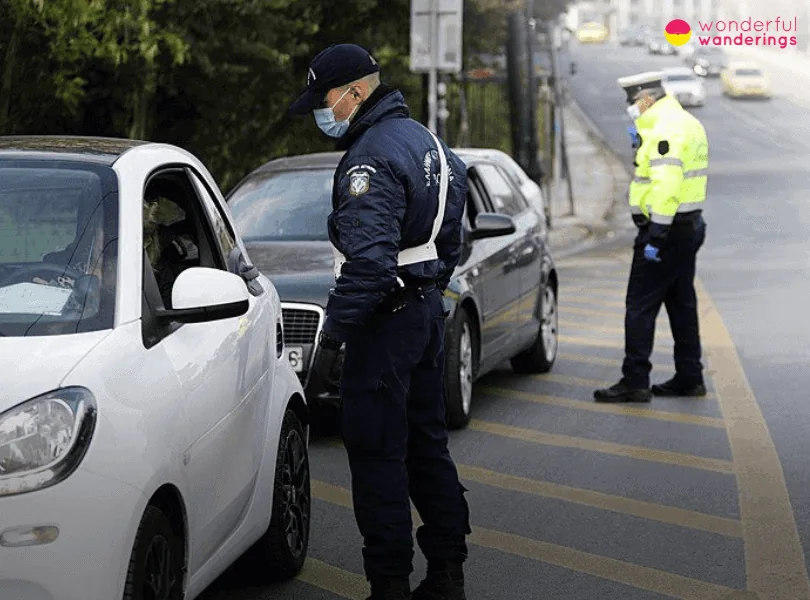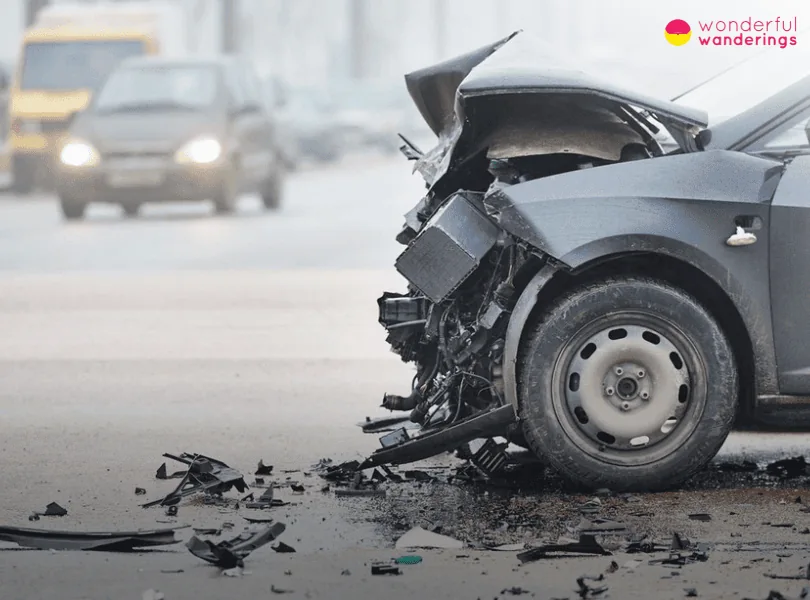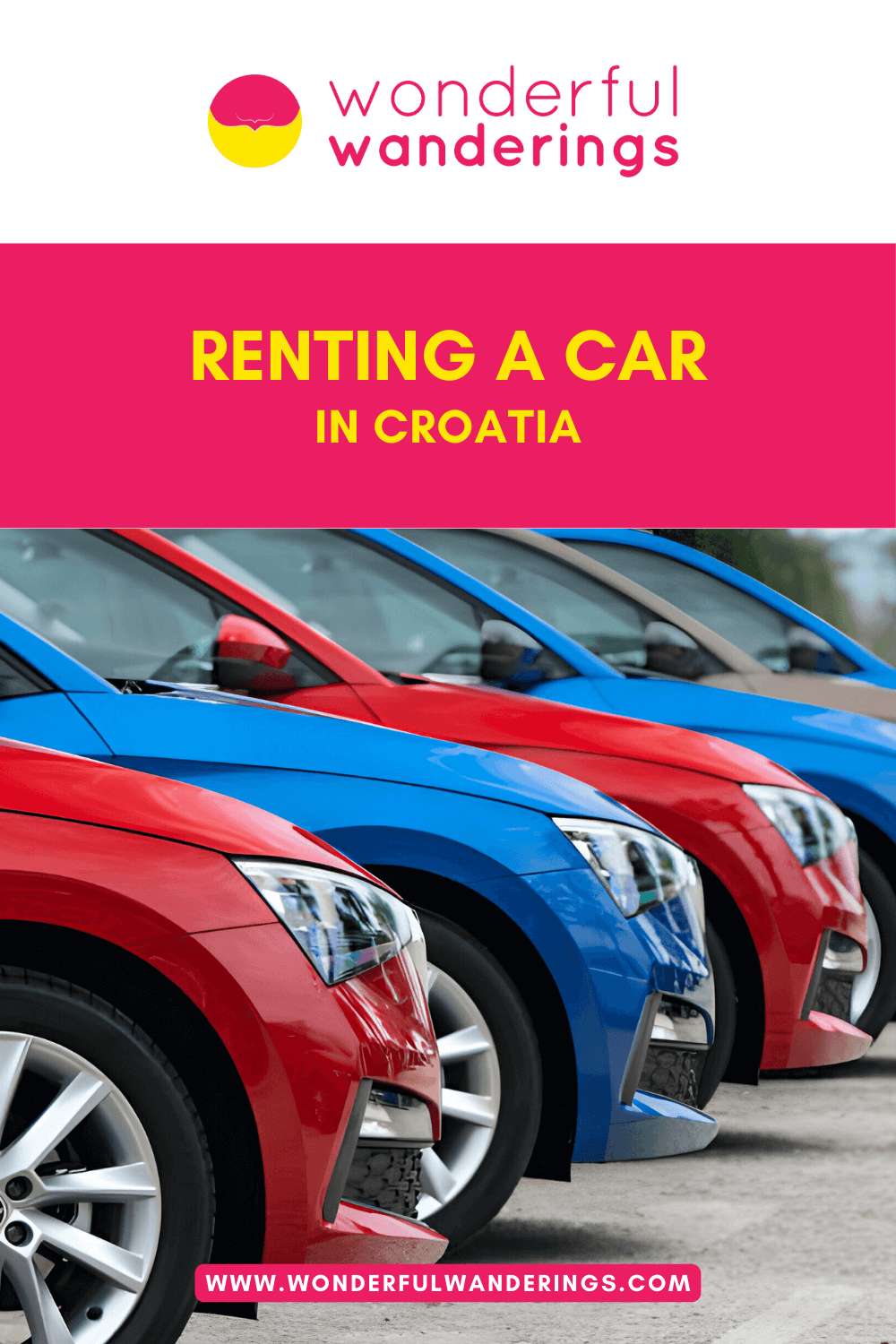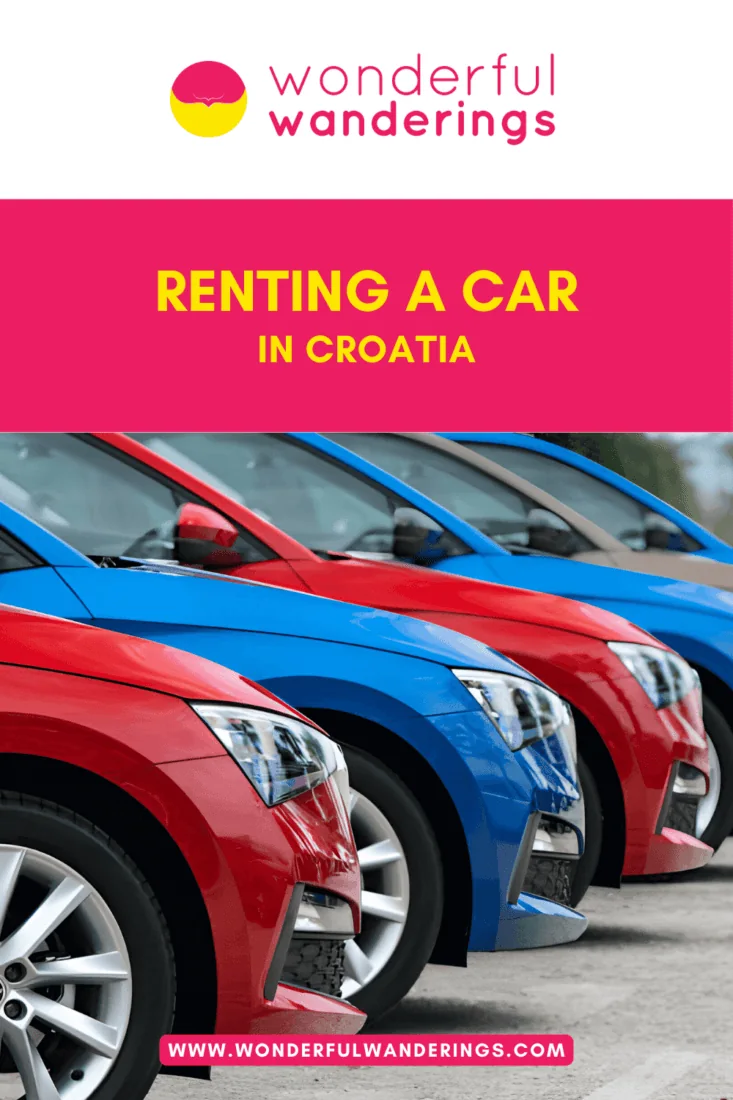Croatia is a Mediterranean country in southeastern Europe, known for its Adriatic coastline with over a thousand islands. Road safety tips when driving in Croatia include always wearing seatbelts and properly securing infants or children in age-appropriate restraints and car seats. Use hands-free devices for calls and avoid distracted driving. Have reflective vests and warning triangles in case of breakdowns. Adjust driving for winter conditions with proper tires or chains if needed for mountain areas. Avoid drinking alcohol and adhere to blood alcohol limits.
Contents
- 1. License to rent a car in Croatia
- 2. Age and Experience Requirement
- 3. Credit Card Requirements
- 4. Guarantee – Credit card hold
- 5. Best period to rent and book
- 6. Pickup / Return Location and Times
- 7. Recommendations for car size and engine
- 8. Transmission type (Manual or Automatic)
- 9. Fuel choice (Diesel, Gas or electric)
- 10. 4×4 rental in Croatia
- 11. RV rentals in Croatia
- 12. Car rental Prices in Croatia
- 13. What to think before selecting a car rental company in Croatia
- 14. Top car rental companies in Croatia
- 15. Save money on automobile rentals in Croatia
- 16. Typical Opening hours of car rental companies in Croatia
- 17. Car rental scams in Croatia
- 18. Cross-board rentals
- 19. Car Rental Insurance
- 20. Roadside assistance
- 21. GPS Sat Nav Navigator
- 22. Additional driver charges
- 23. Child Seats. Safety rules with car rental in Croatia
- 24. Take pics of the car during pick-up
- 25. Mandatory equipment in rental cars in Croatia
- 26. Tolls in Croatia and rental cars
- 27. Traffic fines
- 28. Car rental breakdown
- 29. Fuel refill options
- 30. Different Drop-off locations (Oneway Rentals)
- 31. Car rental Accident
- 32. Double-read the car rental terms and conditions
- 33. Watch YouTube videos of other people driving a car in Croatia
- 34. Plan your Trips
- Is renting a car recommended in Croatia?
- How much does a car rental cost in Croatia?
- What is the ideal car model to rent in Croatia?
- What are the best destinations in Croatia to visit with a rental car?
- What are the top things to do with a car in Croatia?
- What local Croatian food and drinks can you try during a road trip to Croatia?
Proper driving etiquette in Croatia involves using horn warnings to alert any oncoming vehicles when approaching blind corners or spots with obstructed views, especially in rural areas and hills. Drive cautiously on the narrow, winding coastal and mountain roads, allowing extra time as routes can be difficult. Obey speed limits, traffic laws and signs even if locals do not, as authorities can still issue fines traced to rental car drivers. Be alert for pedestrians wandering on roads in villages.
Renting a car in Croatia includes booking small economy cars like VW Polos for easy maneuverability on medieval streets and limited parking. Reserve automatic transmissions early since the manual is standard. Inspect vehicles at pickup and document prior damage with photos. Purchase required rental insurance by law and consider extras like roadside assistance. Read rental contracts carefully to avoid surprise fees. Pay all tolls to avoid administrative fees from rental companies. Driving in Croatia is moderately easy, but winding roads demand alertness. Small rental cars suit the terrain well. Planning routes, allowing extra time and driving carefully make navigating Croatia’s beautiful sites smooth.
1. License to rent a car in Croatia
Travelers looking to rent a car in Croatia must meet several requirements to operate a rental vehicle legally. Renters must be between 18 and 70, additional fees may apply for drivers under 25 or over 70. Renters will need a valid driver’s license from their home country that has been held for at least one year. An International Driving Permit is required for licenses not written in the Latin alphabet. This permit can be obtained for €13 ($15, £11) and is valid for one year. Renters will also need to provide a valid form of identification, usually a passport. Renters will also need a credit card to pay for the rental. Most companies will temporarily hold the credit card to cover any potential damages. Some companies may accept debit cards, but a cash deposit is typically required if a credit card is not provided. Renters must purchase the mandatory rental car insurance in Croatia, as it is required by law. Many rental companies will include basic insurance in their fees, but additional coverage may need to be purchased for full protection against damages or liability. Reading rental contracts is advised so renters understand what is covered and their responsibilities.
2. Age and Experience Requirement
The standard minimum age to rent a car in Croatia is 21-22 years old, some companies may allow drivers as young as 18 to rent by charging extra fees. There is no defined maximum age limit, but drivers over 70 may incur additional charges depending on the rental company’s policy. Renters need to have held a valid driver’s license for at least 1 year to meet the license requirements for renting a car in Croatia. If the license is not written in Latin characters, an International Driving Permit is required in addition to the home country license. This permit can be obtained for €13 ($15, £11) and is valid for one year from the issue date.
3. Credit Card Requirements
Travelers looking to rent a car in Croatia must provide a valid credit card in their name when picking up the rental vehicle, as most car rental companies require credit cards. The credit card is necessary for the rental car company to place a hold on funds in case of any damages or fees incurred during the rental period. Some rental companies may accept debit cards, but a larger cash deposit would be required as security, making a credit card the more convenient option. Using a credit card also provides renters certain protections in disputes over damages claimed by the rental company. Travelers who do not have a credit card or do not want to use one for the rental car should contact rental companies ahead of time to ask about their policies on debit cards and cash deposits. A valid credit card in the renter’s name makes renting a car in Croatia much simpler and more secure.
4. Guarantee – Credit card hold
The deposit to rent a car in Croatia is typically between €1,000 ($1,096, £860) and €3,000 ($3,292, £2, 579). The deposit amount depends on the vehicle rented, rental company policies and insurance coverage purchased. The deposit is a temporary authorization on a credit card, not an actual charge, to cover fees like damages, cleaning or traffic violations. Some companies may allow negotiating to waive certain fees and reduce the deposit. Most Croatian car rentals require €1,000 ($1,096, £860) to €3,000 ($3,292, £2,579) as a refundable deposit authorized on a credit card. Having extra funds for the deposit is advisable when renting a car in Croatia.
5. Best period to rent and book
Renting a car is recommended for exploring Croatia, allowing travelers more freedom and flexibility to access sites inaccessible by public transportation. Booking well in advance, especially for peak summer travel, is crucial as demand for rentals is high. Optimal times for lower rates are the shoulder seasons of May-June and September-October. Small economy cars like a Volkswagen Polo or Fiat 500 are best suited for navigating narrow Croatian streets and finding parking. Manual transmission vehicles are standard, so reserve automatic cars early if needed. Renters should thoroughly inspect vehicles at pickup and take photos to document any prior damage. Tolls exist on Croatian highways and cash or credit cards are accepted. Additional rental insurance should be secured as required by Croatian law
6. Pickup / Return Location and Times
Travelers can pick up and return their rental at the airport or in town. Airport pickup is generally more convenient if arriving by plane, avoiding the need for additional transportation into town. Renting a car from a downtown location is often 10-15% cheaper than at the airport. Airport rental rates include extra fees and taxes that companies pay. Daytime is cheaper than night in Croatia for pickup/return times. Most rental offices close by early evening and any pickups or returns from 6 pm until opening the next morning incur an additional out-of-hours fee. Night pickup may be useful for late arrivals, but expect to pay a surcharge. There are no extra fees for daytime returns. Aim for office hours when starting and ending the rental for the lowest cost. Allow enough time to return the car before the office closes to avoid incurring a night fee.
7. Recommendations for car size and engine
Travelers should consider the geography and their intended route. Much of Croatia has narrow, winding roads along the coast and in old villages best navigated by smaller vehicles. Travelers sticking to major highways may opt for larger cars for comfort. Smaller engines, 1.0 to 1.4 liters, suit most itineraries well, offering fuel efficiency for Croatia’s high petrol prices while providing enough power for hilly terrain. A mini car like the Fiat 500 or Toyota Yaris offers maneuverability for exploring tight medieval streets. Driving the coastline is also easiest with a compact car or small crossover SUV. Travelers wanting more room for luggage and passengers may choose mid-size sedans like VW Jettas or Nissan Altimas. Bigger engines over 2 liters raise rental rates without much benefit on Croatia’s roads. Diesel can save on fuel, but availability is limited. Most travelers will find a standard 1.4-liter gas engine in a VW Polo, Ford Fiesta or similar perfect for driving in Croatia comfortably while watching the budget.
8. Transmission type (Manual or Automatic)
Most vehicles available have manual transmissions, which is the standard across Europe. Manual cars are much cheaper to rent than automatics. Booking an automatic rental car is advisable for travelers not comfortable driving stick-shift vehicles despite the extra cost. Learning manual transmission on Croatia’s narrow, winding roads and hilly terrain will prove extremely challenging. Automatic car rentals book up fast in Croatia, especially in peak summer, so travelers should reserve them well in advance. Travelers should verify automatic transmission when reserving, as the listing sometimes defaults to manual. Expect to pay €13 ($15, £11) to €27 ($30, £23) more per day for automatic car rentals. The extra cost brings significant peace of mind for drivers unfamiliar with stick-shifts. Automatic transmissions simplify the driving experience tremendously for most foreign travelers. The steeper rental prices balance out through avoided stress navigating Croatia’s old mountain roads.
9. Fuel choice (Diesel, Gas or electric)
Travelers can choose several fuel types depending on the car model. Most standard economy vehicles run on unleaded gasoline, which is widely available across Croatian gas stations. Multiple fuel brands to select from when refueling include INA, Petrol, Tifon and Crodux. Travelers should budget gas expenses into their rental costs. Some rental car companies may also offer diesel-powered vehicles. Diesel costs less than unleaded gasoline in Croatia. Diesel rental availability is more limited. Renters should reserve diesel vehicles well in advance if required. There are currently very few hybrid, electric or LPG-powered rental cars available in Croatia due to a lack of charging infrastructure and supply limitations. So gasoline or diesel vehicles are predominantly what travelers will encounter. Travelers should verify which fuel type their vehicle requires to avoid mistakes later. Refueling with the incorrect petrol or diesel could lead to breakdowns or engine damage. Renters must thoroughly check fuel requirements with the rental agent to prevent issues.
10. 4×4 rental in Croatia
An off-road capable 4×4 vehicle is generally unnecessary as most key sites and towns are accessible via Croatia’s well-developed road network. Small economy cars are best suited for navigating the older, narrow streets of cities like Dubrovnik, Split and Rovinj. Larger vehicles may struggle to fit in small alleyways and parking. A standard sedan or small SUV offers plenty of comfort and capability for travelers planning to stick to main routes along the coast and between inland attractions. Diesel vehicles could be chosen for better fuel economy covering long distances. Only those embarking on serious overlanding expeditions into remote mountain or forest terrain would require a true 4×4. An economical car rental of a hatchback or crossover type likely fulfills transportation requirements perfectly for an average itinerary focused on enjoying Croatia’s beaches, islands and villages. Upgrading to a pricier 4×4 strictly for Croatia’s roads is generally an unnecessary expense.
11. RV rentals in Croatia
RV and campervan rentals provide a convenient alternative to hotels. Several companies offer various-sized motorhomes to accommodate couples or groups of up to 6 people. RVs allow stopping wherever desired rather than relying on predetermined hotel bookings. Inside conveniences like kitchens, bathrooms and beds allow travelers to be self-sufficient. Companies like Indie Campers, Happy Campers and Yescapa have fleets stationed across Croatia during peak season. Rental durations are 5-10 days with unlimited mileage. Travelers should book motorhomes well in advance for summer due to high demand. Campsites and service stations across Croatia cater to RV travelers; however, navigating large Croatian cities may prove challenging. Smaller vans are better suited for urban exploration.
12. Car rental Prices in Croatia
The average cost of rental cars in Croatia ranges from €27 ($30, £23) to €64 ($70, £55) per day depending on the type of vehicle, rental company, season and rental duration. Compact cars like the Volkswagen Polo or similar models start at €27 ($30, £23) daily during the off-season. Mid-size sedan models like the VW Golf cost €41 ($45, £35) per day, while standard SUVs €64 ($70, £55) and above. Expect car rental prices to increase by 20-30% in the peak summer months of July and August. Additional charges may apply for extras like GPS rental, additional drivers, one-way rentals, young driver fees, etc. Leading car rental companies operating in Croatia include international brands like Hertz, Avis and Europcar and local companies like Oryx Rentals and Avant Car. When renting for longer durations of 5+ days, weekly rates offer the best value. It is also advisable to book at least 2-4 weeks in advance for the best rates. The key considerations include vehicle size, transmission type (manual vs automatic), mileage limits and insurance options.
13. What to think before selecting a car rental company in Croatia
Travelers should think about several key factors before choosing a company. Firstly, the reputation of the rental company, reading recent customer reviews on sites like TrustPilot can give insight into the quality of vehicles, customer service and overall rental experience for different providers. Secondly, travelers should also compare rates across rental companies, clarifying what is and isn’t included in the base pricing. Some companies advertise very low prices but then tack on excessive fees for insurance, GPS rentals, second drivers, etc. Thirdly, travelers should have a clear understanding of total costs. Vehicle availability should also be checked, especially for automatic transmission cars, which book up faster. Fourthly, travelers may want to filter search results by car size and fuel efficiency. Booking early is advised to secure the best rates and desired car type. Lastly, researching and comparing rental companies helps travelers select the right provider for their needs, resulting in a smoother overall rental experience.
14. Top car rental companies in Croatia
Travelers should consider booking with top providers like Europcar, Sixt, Hertz and Enterprise. Firstly, Europcar has over 15 rental locations across popular destinations like Zagreb, Split, Dubrovnik, Zadar and Pula. Their large European fleet ensures good availability of quality vehicles during peak summer tourist season. Europa allows cross-border travel into neighboring countries. Secondly, Sixt has fewer branches than Europcar in Croatia, with only a presence in Dubrovnik, Split, Zadar and Zagreb. Sixt offers competitive rates and allows one-way rentals between major cities. The rental company has modern vehicles, including luxury cars and SUVs. Thirdly, Hertz maintains multiple branches at international airports and major cities across Croatia. Hertz has a range of vehicles, from economy cars to minivans. Hertz provides GPS rentals and allows cross-border travel with some fee. Lastly, Enterprise relies on local Croatian partners, so fleet options are predominantly mid-sized cars and availability is limited during peak times. Enterprise has renowned customer service and policies around insurance, additional drivers, etc., to help provide a smooth overall rental experience through partners.
15. Save money on automobile rentals in Croatia
There are several ways to save money on automobile rentals in Croatia. Firstly, secure cheap car rental in Croatia by booking in advance, especially for peak summer travel. Prices tend to spike as demand increases, so reserving a couple of months early locks in the best rates.
Secondly, choosing pickup/drop-off in a downtown location instead of the airport can also yield significant savings, as can choosing a smaller, more fuel-efficient vehicle. Travelers can also choose manual transmission cars, which are generally cheaper to rent than automatics in Croatia. Thirdly, travelers should clarify what is included in the base rental rate and what is extra. Some companies advertise very low prices but then tack on excessive insurance fees, GPS rentals, second driver charges, etc. Reading contracts carefully helps avoid surprise costs. Comparison sites like Rentalcars.com enable filtering by different criteria to find the best cheap car rental in Croatia for one’s needs. Lastly, travelers should check if they have credit card coverage to waive some insurance charges. Researching, comparing rental companies and understanding all fees are essential to finding the most affordable Croatia car rental.
16. Typical Opening hours of car rental companies in Croatia
Car rental desks within Croatia’s airports typically open early in alignment with the first incoming flights, from 6 to 7 am. The car rental desk remains open throughout the day into the evening to accommodate both arriving and departing travelers’ transportation needs. The last rental pickups are usually allowed 1-2 hours before the final flight arrival time for that airport. For example, if the last scheduled flight lands at midnight, the cutoff for collecting pre-booked rental cars would be 10-11 pm. Renters should verify the exact opening hours with their chosen rental company. Companies provide 24/7 access via secure key drop boxes for rental car returns at Croatian airports. Travelers can return vehicles anytime without waiting for the rental desk to open. Inspecting the car with counter staff during operating hours is the best practice to confirm no new damages. Renters should time their airport returns during the day rather than making late-night drop-offs. This ensures the ability to address any potential issues and catch flights stress-free.
17. Car rental scams in Croatia
There are several car rental scams in Croatia. Firstly, rental car companies may try to charge renters for damages that existed before renting the vehicle. Companies may also inflate repair costs for any actual damage incurred. It is important to thoroughly inspect and photo document the condition of the rental car before driving off the lot. enters should again insist the car is checked and signed off without additional charges. Secondly, there are hidden fees for dropping off in another location. Some rental companies claim renters can return the car to any of their locations and charge drop-off fees. Thirdly, common add-ons like GPS units and extra insurance may be aggressively pushed on renters, especially foreign tourists. Most people have smartphones with GPS and only need basic insurance that may already be provided by their credit card company. It is best not to purchase optional extras unless the renter fully understands what they are paying for. Lastly, some agencies will note damages on a vehicle after the renter returns and try to charge renters for those damages. Documenting the car’s condition when picking it up and dropping it off protects against this scam. Travelers should also use reputable rental companies instead of shady operators. Checking online reviews can help identify the more ethical car hire firms.
18. Cross-board rentals
Travelers are allowed to take rental cars across borders when renting a car in Croatia and there are some important things to consider. Taking the rental car into Bosnia, Herzegovina or Montenegro is permitted, as Croatia has a “green card” system with these countries that provides the necessary insurance coverage. There are additional fees that may apply, so check with the rental company. In neighboring countries like Slovenia, Italy, Serbia and Hungary, renters need special permission from the rental company to take the car across the border. There is an exception. when driving on the A1 highway along the Adriatic coast, there is a stretch at Neum that passes through Bosnia & Herzegovina territory. This is a domestic route, so no special permission is needed. All land border crossings expect long waits, so allow ample extra time. Carry passports, the rental contract and any other necessary documentation. Taking rental cars on ferries to the Croatian islands is usually permitted, but verify ferry-specific insurance with a rental provider, as regular insurance may not be valid.
19. Car Rental Insurance
There are several insurance packages available when renting a car in Croatia. Firstly, Third-Party Liability (TPL) Insurance covers bodily injury or property damage caused to third parties if the renter is at fault in an accident. PL does not cover any damage to the rental vehicle, the renter or passengers. Secondly, Collision Damage Waiver (CDW) is an optional add-on coverage that reduces or waives the renter’s financial liability for damage to the rental car in case of collisions, crashes, vandalism, etc. CDW will cover repair costs but often has a deductible, meaning renters pay part of the claim. Lastly, Theft Protection (TP) is an optional coverage that reduces or waives the renter’s financial responsibility. TP has a limited deductible if the rental vehicle is stolen during the rental period. The renter could be liable for the full replacement value of the stolen rental car.
It is recommended to purchase the Collision Damage Waiver (CDW) and Theft Protection (TP) when renting a car in Croatia. CDW covers damage to the rental car and TP protects it in case it is stolen. Purchasing CDW and TP adds more to the rental cost as it provides essential protection from potentially having to pay extremely large out-of-pocket expenses in the case of any incidents with the rental car during the trip to Croatia.
20. Roadside assistance
It is recommended to purchase roadside assistance or emergency breakdown coverage when renting a car in Croatia. Extra protection provides peace of mind in case of mechanical issues, flat tires, lockouts, dead batteries or other problems on remote roads. Roadside assistance usually costs €4 ($5, £3) to €13 ($15, £11) per day added to the rental car fee. The rental company or a contracted towing/repair company will then dispatch a technician to the renter’s location who can change a flat, provide a battery jumpstart, unlock the car or even tow it to the nearest authorized repair shop. This convenient service saves renters the hassle of finding and paying a local company. Considering Croatia’s winding coastal and mountain roads, relatively few gas stations in rural areas, summer heat and renters’ unfamiliarity with the environment, roadside assistance is an affordable way to avoid a roadside incident ruining the trip.
Travelers looking to rent a car in Croatia should consider adding a GPS navigation system, which rental companies offer for an extra daily fee. GPS units provided by rental agencies may cost €7 ($8, £6) to €13 ($15, £11) per day. The GPS comes pre-loaded with up-to-date maps and points of interest in Croatia without relying on cellular data. For travelers unfamiliar with driving in Croatia, having an onboard navigation system can greatly reduce the stress of navigating between destinations. It helps avoid getting lost on the winding coastal and mountain roads. The units are easy to use, simply enter a destination and the GPS plots the best route. Some units even speak English. Considering Croatia’s occasionally spotty 3G/4G coverage, an onboard GPS is more reliable than phone maps if service drops out. Adding reliable GPS navigation seems to be a small price for significantly enhanced comfort and flexibility when road-tripping through Croatia’s beautiful countryside and islands.
22. Additional driver charges
Most agencies in Croatia allow travelers to add one or more drivers beyond the primary renter to the rental agreement for an extra daily fee. This is convenient for couples, families or groups sharing driving duties. Rental companies in Croatia charge €4 ($5, £3) to €13 ($15, £11) per day to add an extra authorized driver. Some may cap the number of additional drivers at 1 or 2 people. The exact rate depends on the rental company, vehicle type, season and rental length. Additional drivers must meet the same requirements as primary renters, including age limits, providing a valid license and being present at vehicle pickup. Additional drivers allow travelers to split driving on long trips across Croatia.
23. Child Seats. Safety rules with car rental in Croatia
Travelers must use appropriate child restraints and seats according to age and size. A rear-facing baby seat is required for infants under 10 kilograms (22 pounds). A larger rear-facing or forward-facing convertible seat is needed for older babies from 9-18 kilograms (20-40 pounds). A front-facing toddler seat with a harness is mandatory for toddlers 15-25 kilograms (33-55 pounds). Kids over 25 kilograms (55.11 pounds) must use regular back seat belts, but those under 150 centimeters (59 inches) may use boosters. These all can be rented from rental agencies for €4 ($5, £3) to ($15, £11) per day. Using child seats properly reduces injury risk by over 70% in crashes. Despite the daily rental cost, the safety of infants and toddlers is paramount. Travelers should factor proper restraint expenses into trip budgets and research rental seat options, installation, etc, before arriving. Securing children correctly is crucial when driving in a foreign country.
24. Take pics of the car during pick-up
It is advisable for travelers to thoroughly photograph the car, both interior and exterior, with clear timestamps that prove the images were taken at pickup. This provides evidence of any existing damage like scratches or dents before driving, even minor issues. If the rental company tries to blame the renter for any prior damage noticed when returning the car, having time-stamped photos protects against unfair allegations and charges. Travelers may deal with unfamiliar foreign companies, language barriers and lack of recourse, so documenting the initial condition is critical. Rental agreements can be complex, so photographing is extra insurance against disputes, similar to inspecting flights for luggage damage.
25. Mandatory equipment in rental cars in Croatia
Several mandatory pieces of equipment must be in the vehicle when renting a car in Croatia.
Firstly, a first aid kit is stocked with basic medical essentials to treat minor injuries in case of an accident. Secondly, a reflective safety vest must be worn for each passenger when exiting the vehicle after a breakdown or crash. Travelers should verify these items are in the car before departing the rental facility. Thirdly, a warning triangle should be placed behind the car to alert other drivers if stopped on the road or shoulder. During winter months, between November and April, all rental vehicles must be equipped with winter tires and snow chains may also be mandatory in certain mountainous areas. Lastly, wear seat belts at all times. Child restraints and car seats are compulsory for infants and toddlers based on age and weight. Checking for this critical safety equipment is vital when renting a car in Croatia.
26. Tolls in Croatia and rental cars
Travelers are responsible for paying all tolls accrued during their rental period. Croatia has an extensive motorway system between major cities and to access these faster roads, drivers must stop at toll booths along the route. Cash and cards are accepted for payment. If renters do not pay a toll for any reason, the rental company will charge the cost to the renter’s credit card on file, along with an administrative fee. Unpaid tolls can also build up late fees daily until the rental company receives payment. Travelers must pay attention at toll booths and have cash or a valid credit card ready to pay to avoid extra charges. License plates are scanned so there is a digital record if a rental vehicle passes through without paying. Renters should ensure they pay every toll they incur by the time they return the rental car.
27. Traffic fines
The renter is responsible for paying any traffic fines, including speeding tickets, parking files or penalties incurred during the rental period. This includes fines for speeding, illegal parking, toll evasion or other violations of Croatian traffic laws. When signing the rental contract, the renter provides their personal details and driver’s license information so authorities can trace infractions to the driver. If a traffic camera or police officer issues a ticket to a rental vehicle, the rental company pays the fine first and then charges it back to the driver, along with substantial service fees. Unpaid fines accrue late fees daily and can be referred to a collection agency. The rental company may use the renter’s credit card on file to settle outstanding fines. Failure to pay significant fines can even result in legal troubles or arrest warrants when trying to exit or re-enter Croatia. To avoid complications, renters should drive carefully, observing all traffic and parking regulations in Croatia.
28. Car rental breakdown
There are several ways to deal with a car rental breakdown in Croatia. Firstly, move the vehicle to a safe location out of traffic if possible. Renters can call the 24/7 emergency roadside assistance number the rental company provides, usually found on the key fob or rental agreement. The dispatcher will arrange for a technician to be sent to the vehicle’s location. If the car cannot be quickly repaired, it will be towed to the nearest authorized repair shop.
Secondly, renters should put on the reflective vest found in the car and set up the warning triangle behind the vehicle to alert other drivers. Thirdly, renters may need to arrange a replacement rental car or hotel stay at their own expense, so keeping emergency cash on hand is recommended. Lastly, travelers should not authorize any repairs themselves without approval. Complete documentation, like photos of the incident, is also advisable. Remaining calm and contacting the rental company promptly for instruction is key to resolving a breakdown efficiently while on vacation in Croatia.
29. Fuel refill options
Many car rental companies in Croatia offer travelers a “full-to-empty” fuel policy option; the vehicle is provided with a full gas tank at pickup and the renter can return it empty at the end of the rental. This convenient option allows renters to avoid having to refuel the car before returning it, which can be challenging when on a tight schedule. The full-to-empty policy costs €27 ($30, £23) to €54 ($60, £47), depending on vehicle type and rental duration. This may seem expensive compared to refueling themselves. Renters should weigh the cost and convenience factors based on their itinerary. Some travelers may still prefer filling up at local stations before returning the car. This allows them to track fuel consumption rates during their trip. It also avoids paying for unused fuel if not driving long distances.
30. Different Drop-off locations (Oneway Rentals)
Travelers can do a one-way rental, picking up the vehicle in one location and dropping it off in another city. This convenient service allows more flexibility to customize an itinerary without double back. Most major rental companies in Croatia, like Sixt, Hertz, Europcar and Budget, offer one-way rentals between popular tourist destinations such as Zagreb, Split, Dubrovnik, Zadar and Pula. There is typically an extra one-way fee charged by rental companies for this service. One-way rental fees in Croatia are usually €27 ($30, £23) to €91 ($100, £78), depending on the drop-off distance and rental duration. The further the drop-off location, the higher the one-way fee. During peak summer, fees also tend to be higher. Booking is recommended as one-way rental availability is limited. Carefully comparing different rental company fees helps travelers find the best rate if planning a one-way itinerary to explore more of Croatia’s beautiful coastal regions and islands.
31. Car rental Accident
There are several standard ways to deal with a car rental accident in Croatia. Firstly, remain calm and ensure medical assistance reaches any injured parties. Once the emergency services have been contacted, the renter must notify the rental company and provide details on what happened. Secondly, rental agreements stipulate that the renter should not admit fault or liability to any third parties after an accident. The rental company will guide the renter through filing a police report and insurance claim. Having a European Accident Statement form in the rental car proves helpful for recording key details. Lastly, capturing photos of the damage and the accident scene is also advisable. Photos should capture the position of the vehicles, any skid marks on the road, the relative location of traffic signs or signals and a wide-shot overview of the entire scene.
32. Double-read the car rental terms and conditions
There are several reasons why double-reading the car rental terms and conditions is important. Firstly, it is advisable for travelers to thoroughly read the rental agreement twice before signing and collecting the car. Rental contracts can be complex, with pages of fine print covering items like insurance liability, restrictions on crossing borders or driving on certain roads, young/senior driver surcharges and additional fees for late returns, unpaid tolls or traffic violations. Secondly, double-checking also ensures travelers don’t overlook critical information that could negatively impact their trip. Considering Croatia’s winding roads and unfamiliar signage, plus the stress of driving in a foreign country, the last thing renters need is confusion around contractual obligations. Lastly, taking the time upfront to double-read each section, questionable points or fees can save significant hassles later. A few extra minutes reviewing the terms and conditions provides peace of mind so travelers can confidently hit the Croatian roads.
33. Watch YouTube videos of other people driving a car in Croatia
Watching YouTube videos of other people driving a car in Croatia can be beneficial for several reasons. Firstly, the videos show that many roads in Croatia are quite narrow, with tight turns and winding routes, especially in smaller towns and villages. Drivers need to be alert and careful when navigating these roads. Secondly, videos display many blind corners and spots in Croatia with obstructed views in rural areas and on hills, so drivers must honk their horns and drive slowly to warn any oncoming vehicles. Lastly, some coastal and mountain roads in Croatia have steep inclines or lack guardrails, demanding extra caution from drivers. Key takeaways for driving in Croatia based on others’ experiences are allowing extra time as roads can be narrow and winding, utilizing warning honks at blind corners and driving defensively with locals while enjoying the landscapes.
34. Plan your Trips
Travelers landing at airports in Croatia like Zagreb, Split or Dubrovnik have several transportation choices to reach their accommodation. Firstly, private transfers booked through companies like TransferCroatia, Croatia Transfers or Welcome Pickups provide direct rides from the airport to hotels/apartments in comfortable vehicles like sedans, vans or minibusses, depending on group size. Secondly, rideshare apps like Uber, Bolt and Cool offer airport pickup. The availability may be more limited during peak times. Thirdly, public buses and trains connect airports to central bus/train stations in cities like Zagreb, Split and Dubrovnik. Journeys can take 30-60 mins. Public transit works best for visitors planning to remain within a city. Tickets can be bought at machines in stations or ahead of time. Timetables outline metro, tram and bus schedules and frequencies. Fourthly, major hotel chains and resorts often provide convenient free shuttles for guests, but route options are limited. Independent hotels/apartments rarely offer this service. Shuttle schedules tend to meet major flight arrival blocks. Lastly, renting a car provides maximum flexibility but requires researching companies, insurance options and driving comfort levels beforehand. One-way rentals allow customized trip planning. Reservations are essential during the busy summer season. It also brings navigational and parking challenges when driving in unfamiliar cities, along with rental terms, insurance and fuel costs.
Croatia offers travelers endless scenic driving routes between top attractions along the Adriatic coastline and inland national parks. A 4-5 day road trip could start in the capital, Zagreb, to tour its medieval Upper Town before heading south to admire Plitvice Lakes National Park’s lakes and waterfalls. Continuing down to Zadar on the coast, take in old Roman ruins and the unique sea organ musical instrument. Further south, the walled city of Split makes an ideal base to visit Diocletian’s Palace, go island hopping to Hvar, Brač and Šolta and end the trip in Dubrovnik. Careful pre-trip planning using offline maps helps craft the perfect trip itinerary through Croatia.
Is renting a car recommended in Croatia?
Yes, renting a car is recommended for exploring Croatia. Access to a rental car enables visitors to Croatia to easily reach beautiful sites and destinations not well-connected by public transport. Driving provides the freedom to create personalized itineraries away from crowded tour buses. Travelers can journey down winding coastal roads, discover quiet hilltop villages and access secluded beaches and coves by renting their vehicles. Small economy cars are recommended for navigating Croatia’s narrow medieval streets. Manual transmissions are common, so drivers should verify gearbox type when booking. Travelers wishing to incorporate Slovenia or Montenegro into their journey should confirm rental cars include cross-border insurance. Driving gives travelers the independence to alter plans spontaneously.
How much does a car rental cost in Croatia?
Travelers can expect rates to vary depending on vehicle type, rental duration, season and booking advance purchase. For a small economy car like a Volkswagen Polo or similar, prices typically range from €27 ($30, £23) to €45 ($50, £39) daily in the summer high season if booked at least a month in advance. For longer rentals of a week or more, average rates for compact cars drop to €27 ($30, £23) daily. Midsize family cars suitable for families of 4, like a Skoda Octavia, average €41 ($45, £35) to €64 ($70, £55) daily per day in summer. Depending on demand, luxury SUVs and 4x4s have higher daily rates €73 ($80, £62) to €88 ($100, £75). Renting any car type at the last minute in peak months can cost 40-80% more. Croatia has affordable rental car rates compared to European destinations and booking smaller vehicles for longer periods in shoulder season yields the best value. Locking in rentals early also secures availability, which gets scarce during July and August.
What is the ideal car model to rent in Croatia?
There are several car models to rent in Croatia. Firstly, the Volkswagen Polo or similar subcompact cars like the Toyota Yaris and Nissan Micra are popular rentals that balance size, maneuverability and cost-efficiency. These economy models are compact enough to easily navigate narrow village streets and tight parking spaces while seating four passengers comfortably. Secondly, the Skoda Octavia, Hyundai Elantra and Toyota Corolla are excellent choices for groups needing more space. They offer ample luggage room while still being compact enough for Croatian roads. Lastly, the Volkswagen Golf and similar compact hatchback models offer more interior space than the smallest economy cars while still easily navigating Croatian roads. Popular rental options like the Golf, Opel Astra and Renault Megane fall into this bracket, with the extra cargo capacity suiting those with more luggage while the compact size allows easy parking and driving. These hatchback models provide a nice balance of interior room and maneuverability for exploring Croatia. The Volkswagen Polo or a similar small economy car is the best rental option for road-tripping through Croatia. The Polo has optimal size, fuel efficiency, maneuverability through villages and availability from major rental companies at reasonable rates. Its compact size suits Croatia’s winding roads extremely well for stress-free driving.
What are the best destinations in Croatia to visit with a rental car?
Listed below are the best destinations in Croatia to visit with a rental car.
- Zagreb. Zagreb is Croatia’s capital and largest city, known for its Austro-Hungarian architecture, lively cafes and nightlife. Key sites travelers can drive by include the Gothic Zagreb Cathedral, St. Mark’s Church with its colorful tiled roof and the Museum of Broken Relationships. Zagreb is also one of most amazing Croatian places to visit.
- Plitvice Lakes National Park. Plitvice Lakes National Park is a UNESCO World Heritage site with 16 terraced lakes and over 90 waterfalls surrounded by forests and hiking trails. It is one of Croatia’s most popular attractions. Travelers can drive through and stop to see the lakes and waterfalls.
- Zadar. Zadar is an ancient Roman city on the Dalmatian coast that travelers can drive. It is known for its sea organ, a musical instrument powered by the sea. It features Roman ruins, medieval churches and coastal promenades that travelers can stop to see.
- Split. Split is a bustling port city centered around the UNESCO-listed Diocletian’s Palace that travelers can drive to and explore. It also has beaches along the Marjan peninsula and islands nearby that travelers can take ferries to visit.
- Hvar Island. Hvar Island is a popular island getaway off the Dalmatian Coast that travelers can take a ferry to and drive around. The port town of Hvar features 13th-century walls, a fortress and a scenic coastal promenade. The island is known for beaches, lavender fields and wine that travelers can stop to see.
- Dubrovnik. Dubrovnik is a famous coastal city with a UNESCO Old Town that travelers can drive to. It features red-tiled roofs, medieval walls and monasteries that travelers can walk around and explore. It was made popular as a filming location for Game of Thrones.
- Istria Region. Istria Region is a peninsula in northwest Croatia that features hilltop towns like Rovinj, Pula and Motovun that travelers can drive between and explore. Travelers can stop to see scenic coastal drives and Roman ruins. The region is known for wine, truffles and olive oil.
What are the top things to do with a car in Croatia?
Listed below are the top things to do with a car in Croatia.
- Zagreb Cathedral. Zagreb Cathedral’s spires make it a landmark that road trippers can easily spot when driving into the city center. It is the tallest building in Croatia at 108m, dominates Zagreb’s skyline and can even be seen from the highway leading into the capital. Driving right into Zagreb’s historic Kaptol district, road trip travelers can appreciate the Cathedral’s imposing Gothic architecture and central location.
- Diocletian’s Palace. Diocletian’s Palace is an expansive Roman ruin located in the heart of Split’s pedestrian old town, which can be easily reached by car or road trip. The palace was built in the 4th century AD for the retired Roman emperor Diocletian and now forms the lively core of Split, with restaurants, shops and bars situated within the old walls and structures. Visitors can appreciate the scale of the palace by walking the perimeter, admiring the Temple of Jupiter, the Cathedral of St. Domnius and intricate stonework while exploring the narrow interior streets. Visiting Dioletian’s Palace is one of the things to do in Croatia as a tourist.
- Golden Cape Park. Golden Cape Park’s wooded trails and sea views can be easily reached via the main coastal road into Rovinj, with ample parking at the park entrance for visitors arriving by car or campervan. The park spans over 70 hectares and contains lovely landscaped gardens, remnants of old quarries now used for rock climbing and secluded beaches perfect for swimming during a road trip along the coast. Road trippers can take panoramic vistas over Rovinj, nearby islands and the Adriatic Sea from this protected natural area.
- Museum of Broken Relationships. The Museum of Broken Relationships creatively displays an array of anonymously donated relics tied to failed romances worldwide. Road trippers exploring Croatia’s capital can easily visit this innovative museum to view the intriguing personal exhibits and read the stories of love lost submitted by the public. The museum aims to provide perspective on the universal emotions tied to broken relationships, allowing visitors to reflect on their experiences of romantic betrayal, family estrangement or childhood crushes.
What local Croatian food and drinks can you try during a road trip to Croatia?
Travelers can try several local Croatian foods and drinks during a road trip to Croatia. Firstly, Ćevapi is grilled minced meat sausages found at roadside stands or restaurants for a quick, delicious bite while road-tripping. Secondly, Burek is a savory baked pastry filled with cheese, meat or vegetables, available at bakeries and food stalls that travelers can stop at during their road trip for a popular snack or light meal. Thirdly, roasted lamb and seafood and travelers tripping along the Dalmatian coast can stop to try the delicious roasted lamb and fresh seafood at local restaurants, showcasing local ingredients. Fourthly, Malvazija white wine is an indigenous sweet white wine variety in the Istrian peninsula that lets road trippers taste the essence of Croatia’s wine-making terroir. Lastly, Plavac Mali red wine is famous along the Dalmatian Coast during a road trip that compliments the local seafood and gives a taste of Croatia’s diverse wine regions.
What are the most interesting facts about Croatia?
Listed below are the most interesting facts about Croatia.
- Croatia has over 1,300 islands and islets along its Adriatic Coast. Croatia has over 1,300 islands and islets along its Adriatic Coast, stretching from the Istrian peninsula to Montenegro. The islands have high biodiversity, with over 7,000 identified plant and animal species, including endangered loggerhead sea turtles and monk seals. Tourism focused on the islands’ natural beauty and historic towns is important to the regional economy. The Kornati Islands National Park helps protect this unique island ecosystem. The islands have been inhabited since ancient times. The country has over 1,300 islands, an interesting fact about Croatia.
- World’s Largest Truffle is in Istria, Croatia. The world’s largest truffle, weighing 1.31 kilograms, was found in Istria, Croatia, in 1999 by renowned truffle hunter Giancarlo Zigante. White truffles are rare and expensive, valued for their intense flavor and aroma. The previous record truffle found by Zigante sold for $5,000, but the 2014 Italian record-breaker fetched $61,250 at auction, showing giant truffles’ culinary status. Truffles grow underground in symbiosis with certain trees and must be unearthed by experts and truffle-hunting dogs. This giant fungus certainly crowned Italy as the premier truffle-hunting destination.
- 10% of Croatia are Protected Parks/Reserves. Over 10% of Croatia’s land area consists of protected natural areas, including eight national parks that showcase mountains, lakes and forests. These conservation areas harbor many rare and endangered Croatian species, from lynx to sea turtles. Sustainable tourism centered on Croatia’s hiking brings economic benefits to rural areas and incentives to continue conservation. Croatia’s ecological network is the core of regional biodiversity protection.
- Filming Location for Game of Thrones’ King’s Landing. Dubrovnik, Croatia, was the main filming location used to represent King’s Landing in Game of Thrones. Dubrovnik’s medieval walled Old Town, Gothic architecture, cobblestone streets and proximity to the sea were ideal stand-ins. Many iconic scenes were filmed along the city walls, inside landmarks like churches and palaces and in the harbor, which was converted into the Blackwater Bay battle set.
- Necktie Originated from Croatian Mercenaries. The modern necktie originated from the 17th-century Croatian mercenary soldiers known as Cravats or Croats. This distinctive knotted neckwear was termed a “cravat” in France, leading to the emergence of the modern necktie that remains a staple of formal menswear. Its roots are to the battlefields of 17th-century Europe and the uniforms of Croatian mercenaries.
PIN FOR LATER
Find below our top guides about Croatia.

